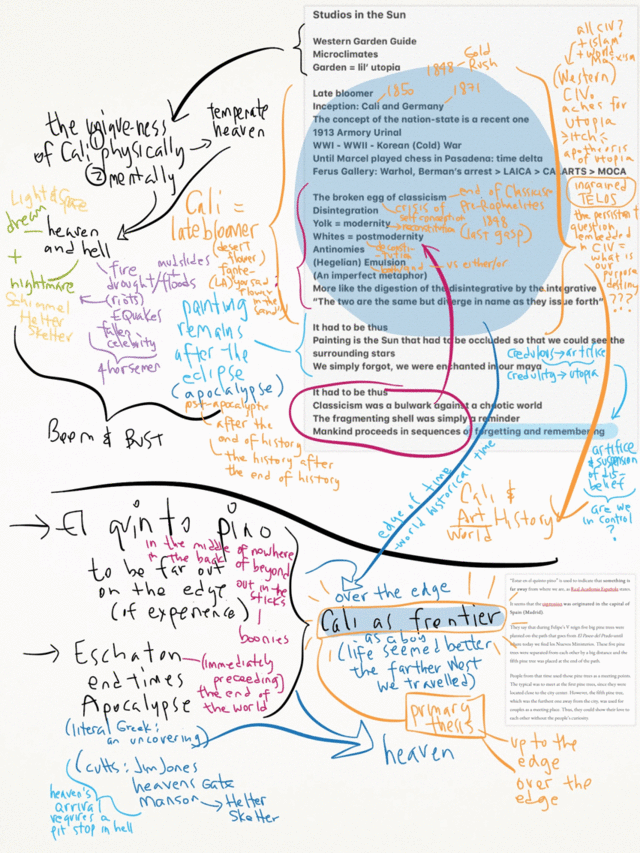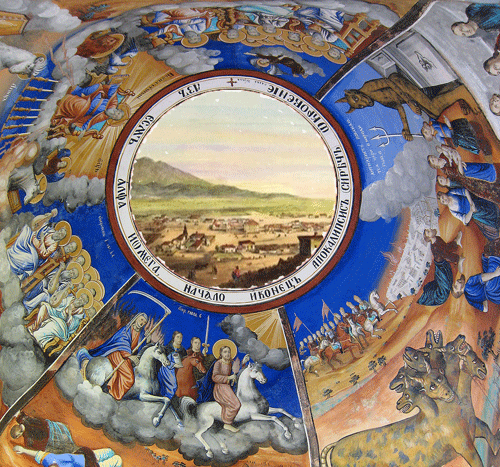March 15, 2019
Painting Towards Paradise

Below the fold, my second try at an intro to painting in California. (First one here) A total fail. After passing 1400 words, I abruptly stopped. Auto-critique: I'm trying to cram too many ideas (it all seems so relevant!) and the focus isn't centering on painting qua painting. The problem is that there is so much back story to tell. Concision. Concision. I'll plunge into another draft after I clear my head.
Postscript:
1. In the piece, I pegged the problem apocalyptic Utopianism inherent in Western Civilization but afterwards, I remembered the Ghost Dance, a Native American religious movement in the late 1800's led by a charismatic leader who yearned for deliverance to a Promised Land. The urge I'm describing is universal.
2. This morning, we awoke to the horrific news of the mosque terror attack in New Zealand. Add to the list of apocalyptic visionary cults, Accelerationism. However benign it had started (contestable), it has become a political version of Charles Manson's Helter Skelter. Ruinous factional infighting is what they want. Every sane person must resist that call. The assailant/murderer has inflicted terror for its own sake (a precise definition of evil). As the line in the movie "Dark Knight" goes: "Some men want to see the world burn." The irony of the Information Age is that the deluge of data blinds us, rendering us prey for predators. Analysis and concision are capabilities that must be mastered, today's urgent survival skill.

Describing painting in California is a formidable task, not only because this art form in that particular place had bloomed only recently, but also since the task of characterization comes framed within a complex civilizational context. Both aspects share frontiers, and all frontiers are the extreme boundaries of distinct entities. It's a big table to set, but we are almost late for the banquet, so we must hurry.Posted by Dennis at March 15, 2019 1:32 PMThere is an expression in Spain, "estar en el quinto pino", which means to be far out on the edge, in the middle of nowhere, in the back of the beyond, out in the sticks, the boonies. During the reign of Felipe V, there were five large pine trees planted from the Prado to the Nuevo Ministerios at the edge of Madrid. The fifth pine was where romantic couples would meet in private. It was Spain that established the chain of 21 missions along El Camino Real from what is now Mexico northward into California, subduing and/or subsuming various Native American populations into Western custom and civilization, a project that lasted about a hundred years. The frontier of Western Civilization imposed upon the Native Americans an apocalypse that was already internalized within the frontier of its own mentality.
It is interesting to consider that California as a state is a late bloomer. Its inception dates to 1850. The concept of the nation state too, is a relatively recent phenomenon. Germany, for example, came into being in 1871, a hundred years after the USA. Before then, all was empire. By the time California came into being, classicism disintegrated and modern art was born. The last gasp of classicism was the era of the Pre-Raphaelites in 1848, the same year of the California Gold Rush. Classicism was the bulwark against a chaotic world and with its demise, Western Civilization transmogrified chaos into itself, ferociously creating the new much faster that it could be digested into canon. Lest we self flagellate with ecstatic self recrimination, consider the sobering possibility ...or probability that the civitas of Western Civilization is really world civilization since Islam is an Abrahamic religion and Marx persuaded large parts of Eurasia, Africa and the Americas. Classicism evaporated when the Imperial empires collapsed and what remained was simply Civilization, the prefix "Western" rendered meaningless.
Think about all that had happened before California got into its stride. We could talk about the succession of ruinous wars in the 20th century, but let's talk about art. Impressionism occupied the last decades of the 19th century and Duchamp's urinal astonished America in 1917, sixty seven years after California was born. Abstraction came into being at the time of Malevich and reached its zenith with the monochromes of Yves Klein. Cubism was codified by Picasso and Braque and evaporated with DeKooning's alzheimer. Schwitters kick-started collage, which became a preoccupation for writers and thinkers in regards to a foreboding sense of the fragmentation at large in modernity. The anarchism of Alfred Jarry infused Duchamp's project and decoupled Descartes' mind/body paradigm, freeing the ghost of conceptualism from the machine, which ripened with Sol LeWitt's fruit of the postmodern tree as the completely dematerialized art-as-a-set-of-instructions. Wallace Berman was arrested by the LA vice squad in '57, Warhol failed to sell his Brillo Boxes via the Ferus Gallery in '62 and Marcel Duchamp returned to America to play chess with Eve Babitz in Pasadena in '64. All of these events occurred in train and it could be argued that California art didn't really begin in a robust manner until this grand cycle achieved precession. While there were important precursors, serious world contemporary art in California really began in the 70's with the activities of the Los Angeles Institute of Contemporary Art (LAICA) and the legendary art school called CalArts which established the pattern that all other art schools in that region modeled themselves by. In the context of all discussed above, art in California has a very recent pedigree.
Yet even as a late bloomer, blooming is what California does best. The Sunset Western Garden guide book is emblematic. The multitude of climate zones between San Fransisco and San Diego, between the cold Pacific and the hot inland desert all share an idyllic temperate condition that is rare in the world. Edenic. Elysian. Paradisiacal. Even the smallest garden is assisted in heavenly transport by yearlong mild temperatures and a sweet on and offshore breeze. But as novelists have noted such as Nathaniel West's "Day of the Locust" or John Fante's "Ask the Dust", heaven is always in conjunction with hell. Historians such as Kevin Starr have commonly emphasized the boom and bust narrative ingrained in the California mindset. After the zenith, the nadir. California has it's own four horsemen of fire and drought, periodized rioting, earthquakes, and the fallen celebrity icon. It wasn't until the 90's that the California identity of Light and Space was brought into balance with Paul Schimmel's "Helter Skelter". It wasn't until this counterpoise that we could even begin to understand events such as Jonestown, Heaven's Gate or the Mason Family. The eschaton is the final event in the divine plan that ushered in the end of the world and this scenario dictates that to enjoy pleasure, one is obliged to endure pain.
The idea of apocalypse yolks heaven and hell, the latter being the necessary augur of the former. Civilization -the one that has prevailed- aches for utopia, the itch of an apotheosis insatiable. The Greek root of apocalypse means to uncover or reveal. It is as if life is so full of hardship that it must in the final act, mean something. Telos is ingrained in humanity, or what I have been referring to here to as civilization. What is our purpose? What is our destiny? We drive and drive and drive each in our own way and perhaps in different directions, but all in unison towards the expectant heaven on earth.
Sir Thomas More wrote "Utopia" in 1516 and his intentions have been debated ever since without resolution as to whether he was earnest or satirical. From then on the reference frame of a conjured idealistic proposition became reified by a crucial increment from imagination to reality simply by being given a name and a few features described. The possibility of the perfect world became tantalizing. Such is the power of art. Suddenly, for the credulous among us, paradise was in our reach. Why is it the we are so disposed to credulousness when it comes to instruments of artifice? Artifice is the clever or cunning device or expedient, especially as when used to trick or deceive others. This might at first blush seem to be condemnatory, but remember that Odysseus was lauded as a skilled artificer. War is, after all, as all martial arts from fencing to chess, based on deception. Plato might not have liked the arts because verisimilitude is a pale reflection of the Real, but industrious Hephaestus was a god even though he was the lame one. We suspend our disbelief when we watch a movie or a play, but we do it voluntarily, ready to reengage it at any time. Why then is it in our grand drama of civilization, that we are so ready to believe in a literal heaven come to earthly existence? Perhaps it is because the churn of (post)modernity has blurred the line of imagination and reality?
All of these huge intertwining cyclic themes serve to set the stage so that we may understand the current state and vexing puzzle of and for contemporary painting in California. Making art after the 90's is simultaneously pre and post-apocalyptic. Painting in California, especially in Southern California, lives that peculiar dream more vividly than most other regions in the world. All manner of cycles, world and art historical, have gyrated to what appears to be a completion. What does one paint in paradise? Is it even possible to paint in hell? Art in California is in constant reference to the interpolating edge of history either approaching the eschaton, within the churn of apocalypse or in the thrall of the millennia. I have heard it said that when babies are overwhelmed, they calm themselves by looking at their hands. The artists who paint in the cali-context described here have looked at the medium in a similar manner. To paint in thrall or madness or paradisiacal lassitude is nearly impossible. So they study the nature of the medium for a sign of how to move forward, like a dowser divining the location of water.
Leave a comment